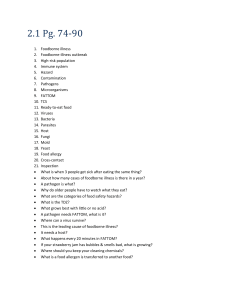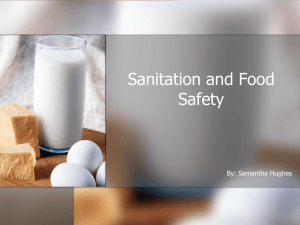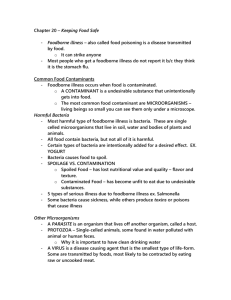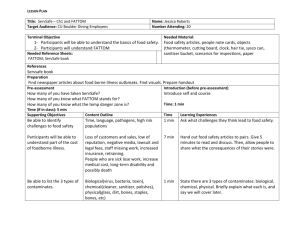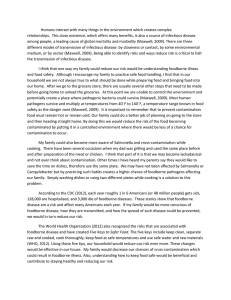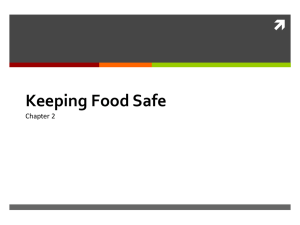Food Safety Learning Modules
advertisement
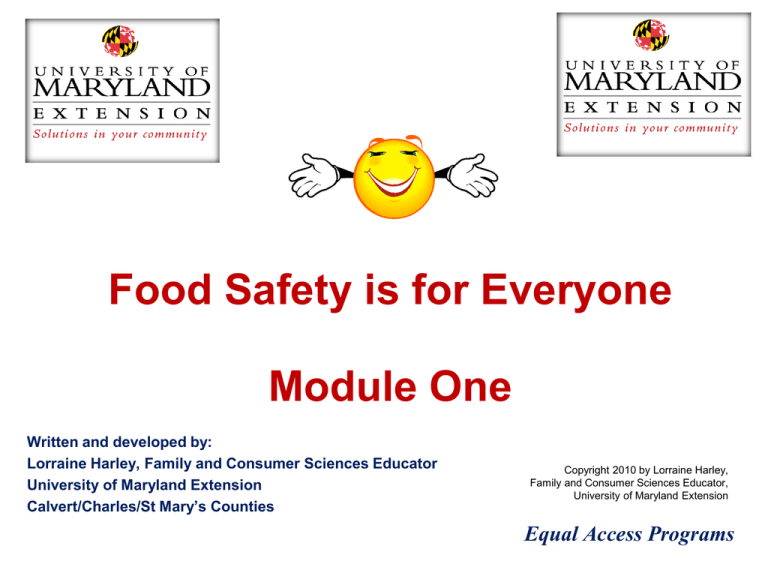
Food Safety is for Everyone Module One Written and developed by: Lorraine Harley, Family and Consumer Sciences Educator University of Maryland Extension Calvert/Charles/St Mary’s Counties Copyright 2010 by Lorraine Harley, Family and Consumer Sciences Educator, University of Maryland Extension Equal Access Programs Module 1 Foodborne illness Copyright 2010 by Lorraine Harley, Family and Consumer Sciences Educator, University of Maryland Extension What is foodborne illness??? “When a person becomes ill after ingesting contaminated foods or beverages.” Estimated foodborne illnesses and deaths in the United States each year: 48 million people get sick (or 1 out of 6) 128,000 are hospitalized 3,000 deaths Centers for Disease Control and Prevention 2011 Estimates Estimated foodborne illnesses and deaths in the United States each year: Common symptoms of foodborne illness: Nausea Vomiting Diarrhea Abdominal cramping Fever Headache Dehydration Blood or pus in the stools Foodborne illness can be caused by: Biological hazards (bacteria, viruses and parasites) Chemical hazards (cleaning agents, toxins) Physical hazards (bone, glass, metal, false fingernails, plastics) Parasites Causative agents implicated in foodborne illness 39% 59% 2% Bacteria Parasites Viruses Causative agents implicated in foodborne illness Most foodborne illness is caused by viruses. Centers for Disease Control (CDC) 2011 Bacterial growth Bacteria multiply rapidly by dividing: 1,2,4,8,16,32,64…etc. Most at risk populations: Infants and young children Older adults Most at risk populations continued…. Pregnant women Immunocompromised populations A few facts about foodborne illness: Common Under reported It contributes to many cases of sickness and death each year Facts about foodborne illness continued… It is very costly $$$$$ Why are we hearing so much about foodborne illness now? A growing problem: Increase in foodborne pathogens Antibiotic resistant pathogens Better methods of detection and identification Why are we hearing so much about foodborne illness? Continued… More centralized food distribution Why are we hearing so much about foodborne illness continued… Globalization Why are we hearing so much about foodborne illness Continued… Change in consumer demographics Human behavior Why are we hearing so much about foodborne illness continued… Education Schools/home Travel Sources of foodborne illness continued… Food contact surfaces Animals, insects, rodents Sources of foodborne illness Contaminated foodhandlers Sources of foodborne illness Contaminates in: air, water, soil and fresh manure Foods most associated with foodborne illness… Raw foods of animal origin Foods associated with foodborne illness continued… Raw and undercooked shellfish Foods associated with foodborne illness continued…Fruits and vegetables Foods most associated with foodborne illness continued… Alfalfa sprouts and raw sprouts Unpasteurized milk, fruit juice Top 5 pathogens contributing to domestically acquired foodborne illness Pathogen Norovirus Salmonella (nontyphoidal) Clostridium perfringens Campylobacter Staphylococcus aureus % 56 11 10 9 3 Top 5 pathogens contributing to domestically acquired foodborne illnessis resulting in death Pathogen Est. # of deaths Salmonella Toxoplasma gondii Listeria Norovirus Campylobacter 378 327 255 149 76 % 28 24 19 11 6 To Learn More: http://www.fsis.usda.gov/Fact_Sheets/ http://originwww.fsis.usda.gov/Fact_Sheets/Kitchen_Co mpanion/index.asp www.cdc.gov--and type in food borne illness. Copyright 2010 by Lorraine Harley, Family and Consumer Sciences Educator, University of Maryland Extension Food Safety is for Everyone Module Two Lorraine Harley MS Family and Consumer Sciences Educator University of Maryland Extension Calvert/Charles/St Mary’s Counties Copyright 2010 by Lorraine Harley, Family and Consumer Sciences Educator, University of Maryland Extension Equal Access Programs Module 2 Personal Hygiene Copyright 2010 by Lorraine Harley, Family and Consumer Sciences Educator, University of Maryland Extension Personal Hygiene: Handwashing is the single most important means of avoiding sickness and preventing the spread of disease Also, teach your children how to wash their hands properly www.cdc.gov Where to Wash Critical handswashing steps Wet your hands thoroughly with warm water and add soap Thoroughly scrub your hands, wrists, fingernails, and in between fingers – for at least: 20 SECONDS Rinse, then dry hands with a clean cloth towel or use a paper towel Antibacterial soap vs. regular soap There is no evidence to indicate that that antibacterial soap cleans more effectively than plain soap For that reason, plain soap is recommended in public, non-healthcare settings and in the home Unless otherwise instructed by your doctor When should we wash our hands in the home? Before eating After changing diapers After coughing or sneezing When should we wash our hands in the home ??? Continued… After blowing your nose After taking out the garbage After using the bathroom Pet Alert-Salmonella transmission Contact with animals that carry Salmonella – – – – – Turtles Reptiles Water frogs Chicks Rarely through water Animals County fairs Petting zoos Barns Home/daycare When should I consult a doctor? “High fever (over 101.5 F) Blood in stools Prolonged vomiting Diarrhea lasting more than 3 days Dehydration – – – Decrease in urination Dry mouth and throat Dizzy upon standing Copyright 2010 by Lorraine Harley, Family and Consumer Sciences Educator, University of Maryland Extension To Learn More: http://www.fsis.usda.gov/Fact_Sheets/ www.cdc.gov/Features/HandWashing http://www.cdc.gov/foodsafety/facts.html#wh enconsultdr Copyright 2010 by Lorraine Harley, Family and Consumer Sciences Educator, University of Maryland Extension Food Safety is for Everyone Module 3 Written and developed by: Lorraine Harley, Family and Consumer Sciences Educator University of Maryland Extension Calvert/Charles/St Mary’s Counties Equal Access Programs Module 3 Crosscontamination Cross contamination: Is the transfer of a harmful substance from: • • • Food to food Equipment/utensil to food People to food How does cross-contamination occur? Poor personal hygiene Raw food in contact with ready to eat foods Contact with contaminated surfaces Improper storage practices Contact with comtaminated food service workers Contamination from consumers Human Hands (C-L-E-A-N) • Human hands • Poor personal hygiene S-e-p-a-r-a-t-e • Direct contact from raw food to a readyto-eat foods Food contact surfaces… Equipment Utensils Wiping cloths Contact surfaces: A word about cutting boards…. Wood or plastic Food contact surfaces continued… What about that Sponge? Let’s go shopping S-E-P-A-R-A-T-E Shopping continued… Obey the 2 hour rule in every situation! The clock is ticking Avoid Improper storage practices Perishable food Frozen food Shelf-stable food F.I.F.O Refrigerator storage time A general rule for cooked leftovers: 4 days Raw poultry and ground meats: 1 to 2 days When in doubt toss it out!! Using hair restraints Family gatherings Picnics Church socials Contamination from ice Remember! Ice used to keep foods cool is not safe for human consumption To help prevent cross contamination: Clean Separate Cook Chill Copyright 2010 by Lorraine Harley, Family and Consumer Sciences Educator, University of Maryland Extension To learn more: www.fsis.usda.gov/Factsheets/Be_Smart_Keep_Foo ds_Apart/index.asp http://www.foodsafetysite.com/educators/competenci es/foodservice/cleaning/cas1.html http://www.fsis.usda.gov/PDF/Kitchen_Companion_ Single.pdf Food Safety is for Everyone Module Four Written and developed by: Lorraine Harley, Family and Consumer Sciences Educator University of Maryland Extension Calvert/Charles/St Mary’s Counties Equal Access Programs Module 4 Temperature Matters Temperature matters: Proper: Thermometer use Cooking Cooling Thawing Reheating Hot holding 140° 40° Why use a food thermometer? To confirm safe minimum internal food temperatures to prevent foodborne illness “It’s Safe to Bite When the Temperature is Right” Which burger is safe to eat? Which burger did you pick? Temperature matters! How to use a food thermometer All ground beef, veal, pork, lamb, chicken & turkey 160 °F Temperature Matters! “Whole cuts of meat,” Including roast, chops and steaks 145 °F 3 min. rest period Fish 145 °F Temperature Matters! All turkey, chicken & duck whole, (pieces & ground) 165 °F Fresh ham Raw 145°F Fully cooked ham To heat: 145°F All egg dishes: 160 °F All leftovers of any type: 165 °F Safety Versus Doneness Refrigerator/freezer temperatures Refrigerator 40° or slightly below Freezer 0° F Thawing food safely When was the last time you thawed food? What method did you use Thawing food safely continued… There are 3 safe ways to thaw food safely: In the refrigerator In the microwave or In a tub or pot of cold water Thawing food safely Continued… Gee, I think I changed my mind. I don’t want to eat the food I just thawed out. Can I re-freeze the food?? Reheating foods safely Microwave Stove top Oven Microwave cooking Microwave cooking does not always provide even heating. After defrosting in a microwave, always cook foods immediately Cooling foods down Do not overfill the refrigerator Break large pots into shallow containers Break down large pieces of meat and turkey Thunderstorms The refrigerator The freezer To learn more: www.fsis.usda.gov/factsheets/Be_Smart_Keep_Foo ds_Apart/index.asp http://www.fsis.usda.gov/factsheets/refrigeration_&_f ood_safety/index.asp http://www.foodsafety.gov/keep/charts/eggstorage.ht ml
